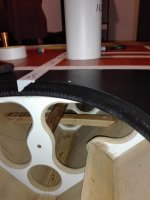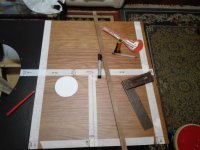Guerrilla say :
Would using multiple ports of smaller diameter be an option?
Answer
It is not valid, this is the best, I have already explored it, thank you.
The problem is that it is a prism-shaped box with internal bracing that is best avoided, and the more ducts you use, the diameter gets smaller but the length increases a lot.
PS:
I hope you're not Aussie....🙄😆
Would using multiple ports of smaller diameter be an option?
Answer
It is not valid, this is the best, I have already explored it, thank you.
The problem is that it is a prism-shaped box with internal bracing that is best avoided, and the more ducts you use, the diameter gets smaller but the length increases a lot.
PS:
I hope you're not Aussie....🙄😆
I lived with a speaker that has group delay like crazy . It almost trun into echo. Fukin hell it was crazy. Its like sound never disapear at 44hz its keep ringing on and on and on.
BP's rule! Sealed and BR's are both high distortion garbage. If a driver moves, then it distorts. Drivers move LESS in BP vs Sealed or BR enclosure per a given voltage. But what do I know, I'm just a CAR AUDIO basshead.Good question. I've dabbled in this for a while.
My 'general' observations:
- sealed boxes offer a 'cleaner' sound (less affected by port turbulence etc)....so maybe better for hi-fi/music listening vs HT applications
- ported boxes offer lower frequencies (for the same driver / box size), so better if you don't need to overly EQ a woofer in a sealed box to obtain the same result.
- ported boxes to have a different sound, less 'tight/dry.'
May I ask, is your main listening two-channel hi-fi or home theatre/stereo combined?
Have you considered different room placement for the existing subs to see if this gives a noticeable improvement in sound quality?
Of course, if you wanted effortless/rich bass, you could consider something substantial like a tapped horn or a Bill Fitzmaurice Tuba sub..., which I can attest to.
The ‘odmlTL’ version of this (which is just assuming a port size that doesn’t get noisy)I am a fan of low tuned reflex ports. If possible to 20 Hertz but 30 or 35 Hertz will do, too.
You do not need then a filter below tuning frequency for driver protection against large excursion.
Yeah, but it requires a decent motorforce and a rigid cone to be in that environment of ‘cone control’ or fail…. puckering on the dust cap glue joint, or fatiguing across the large diameter into folding up like a taco…. in order to succeed there without the ‘distortion garbage’ so it’s not always so easy . And car audio drivers tend to have horrible motor designs with inductance, and I’ll kinds of crimes against humanity.😝BP's rule! Sealed and BR's are both high distortion garbage. If a driver moves, then it distorts. Drivers move LESS in BP vs Sealed or BR enclosure per a given voltage. But what do I know, I'm just a CAR AUDIO basshead.
Speaking of group delay, and the early mention of a "one note samba:"
What would happen if you designed a BR with four ports, but ran the numbers for four different (but close) tunings, then made one port for each tuning? Might that not sort of even things out, or at least make it a "four note" samba?
Or would they just add together and act as one port, anyway?
----------------------------
Also, (And it should be obvious that I don't really know what I'm talking about, lol....) would using smaller drivers / hence small boxes make group delay lower, since there's less distance from driver to the back of the cab and then to the port?
Or would that even matter?
What would happen if you designed a BR with four ports, but ran the numbers for four different (but close) tunings, then made one port for each tuning? Might that not sort of even things out, or at least make it a "four note" samba?
Or would they just add together and act as one port, anyway?
----------------------------
Also, (And it should be obvious that I don't really know what I'm talking about, lol....) would using smaller drivers / hence small boxes make group delay lower, since there's less distance from driver to the back of the cab and then to the port?
Or would that even matter?
As for the original question - Nothing I've tried beats my four sealed 18's for clarity. The recording engineer in me loves them.
But try to get decent volume from them on a 16a circuit at an event? Good luck. The DJ in me HATES them.
I've probably melted more Lab Gruppens than Clair Brothers.
When circuit breakers see me coming, they jump out of the service box and hide.
Also, the sealed subs don't seem to deliver that "fun" factor that dancers love. Sure, that ported sound isn't accurate, but it does hit you in the chest nicely. With sealed subs, you can "kind of sort of" dial it in with careful EQ, but it's just not the same as what comes out of a good BR box.
Horn subs would be another thing altogether, but I don't have much experience with them.
But try to get decent volume from them on a 16a circuit at an event? Good luck. The DJ in me HATES them.
I've probably melted more Lab Gruppens than Clair Brothers.
When circuit breakers see me coming, they jump out of the service box and hide.
Also, the sealed subs don't seem to deliver that "fun" factor that dancers love. Sure, that ported sound isn't accurate, but it does hit you in the chest nicely. With sealed subs, you can "kind of sort of" dial it in with careful EQ, but it's just not the same as what comes out of a good BR box.
Horn subs would be another thing altogether, but I don't have much experience with them.
[QUOTE="Cableaddict, post: 7234762, member: 38
I've probably melted more Lab Gruppens than Clair Brothers.
When circuit breakers see me coming, they jump out of the service box and hide.
[/QUOTE]
Switch to Class D amps and you can run a lot of power trough a 20amp circuit
I've probably melted more Lab Gruppens than Clair Brothers.
When circuit breakers see me coming, they jump out of the service box and hide.
[/QUOTE]
Switch to Class D amps and you can run a lot of power trough a 20amp circuit
One note BR is what happens when marketing trumps engineering, much like PMPO watts, it is something that should only be experienced in products with really bad design choices.one note
Good BR boxes are not synonymous with "one note bass", good BR boxes do not exhibit "chuffing".
Hey Kaffi,One note BR is what happens when marketing trumps engineering, much like PMPO watts, it is something that should only be experienced in products with really bad design choices.
Good BR boxes are not synonymous with "one note bass", good BR boxes do not exhibit "chuffing".
So what's the deal with BR boxes , how do your simulation must look so you do not end with a one note wonder box, you said bad designed BR do that.
And also I read BR boxes are the ones with the greater distortion unlike TH.
Haven't heard a good TH system live but last weekend I watched 4 KS118 (2 per side ) from about 75 feet and there was some nice thump were i was standing, it was a live band.
So I guess 4 SS15 will surpass that easily.
Not to say 4 keystones or TH18's that will sound sound monstrousingly loud and clear.
Making those 4 single reflex sound like Fisher Price toys.
I can't wait the day that I will have my built subs.
Anything other than a single, round, flared and properly sized port is sub-optimal, will reduce output, and add distortion.Would using multiple ports of smaller diameter be an option?
As far as increased group delay with an eq’d SB. If you use a Linkwitz transform or other pole shifting eq circuitry properly the group delay will be equal to the compensated SB tuning frequency and Q. So it’s still low. If you use an underdamped second order HP filter to EQ then group delay will be increased by the EQ since you are converting it to a 4th order electrical + acoustical alignment at a relatively high frequency.
Right now, as an experiment, I have my subs in near field with a bit of time delay on them. Works really well. Immediate increase in lower mid/ upper bass transparency. The subs run at a lot lower volume, so excite room modes less in this configuration. You can get away with smaller subs but I find 2 works best, 1 or each side and slightly behind my listening position to prevent localization.
Right now, as an experiment, I have my subs in near field with a bit of time delay on them. Works really well. Immediate increase in lower mid/ upper bass transparency. The subs run at a lot lower volume, so excite room modes less in this configuration. You can get away with smaller subs but I find 2 works best, 1 or each side and slightly behind my listening position to prevent localization.
The Bose response curve!One note BR is what happens when marketing trumps engineering
I convert sealed boxes to bass reflex designs with dsp digital eq and measurement equipment.
Theory says - and I tried out - that linearized high q drivers sound ok.
So acoustic response is of quality if the summed transfer function of eq and driver give the wanted frequency response.
Theory says - and I tried out - that linearized high q drivers sound ok.
So acoustic response is of quality if the summed transfer function of eq and driver give the wanted frequency response.
What would happen if you designed a BR with four ports, but ran the numbers for four different (but close) tunings, then made one port for each tuning? Might that not sort of even things out, or at least make it a "four note" samba?
Or would they just add together and act as one port, anyway?
----------------------------
Also, (And it should be obvious that I don't really know what I'm talking about, lol....) would using smaller drivers / hence small boxes make group delay lower, since there's less distance from driver to the back of the cab and then to the port?
Re 4 different tunings, that would not work properly.
Each vent stops providing any useful acoustic loading as you go below its resonant frequency and starts acting like a simple hole in the box. Therefore as soon as you're below the frequency of the highest tuned vent, you've already wrecked the possibility of the other three vents working properly. If all the tunings were quite close together, you might be lucky and get a response that's roughly the average of all of them but probably with a lower Q, ie less added output and less control of cone excursion.
Re driver size, no, that's not directly linked to phase/group delay. Phase and GD are determined by the overall shape of the frequency response, so if we had 2 systems based on different driver sizes, but having the same frequency response, they would also have the same phase/GD.
- Home
- Loudspeakers
- Subwoofers
- Sealed subwoofer to bass reflex, what do I gain and what do I lose ?

